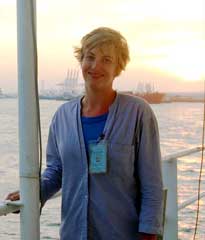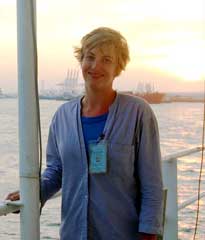 NARRAGANSETT, R.I. – February 12, 2015 – As an undergraduate studying physics at the University of Guelph in Ontario, Melissa Omand wrote software that simulated X-ray emissions from Mars rocks that was later used as part of one of NASA’s Mars Lander missions. It was a turning point for the newest faculty member at the University of Rhode Island’s Graduate School of Oceanography.
NARRAGANSETT, R.I. – February 12, 2015 – As an undergraduate studying physics at the University of Guelph in Ontario, Melissa Omand wrote software that simulated X-ray emissions from Mars rocks that was later used as part of one of NASA’s Mars Lander missions. It was a turning point for the newest faculty member at the University of Rhode Island’s Graduate School of Oceanography.
“That’s when I realized that I wanted to combine physics and earth science,” said Omand, a native of Toronto who now lives in Falmouth, Mass., and began work at URI in January. “My physics training up to that point hadn’t been applied. I realized that I wanted to apply it to improve our understanding of Earth systems.”
It led her to pursue a doctorate in physical oceanography and become involved in interdisciplinary projects combining ocean physics and biological oceanography. Motivated by the effects of harmful algal blooms and red tides on fisheries and swimmers, she conducted a series of experiments that examined how currents, tides and other physical forces in nearshore waters affect the movement and distribution of phytoplankton.
She continued that work as a postdoctoral researcher at the Woods Hole Oceanographic Institution, where she studied a large plankton bloom that appears every year south of Iceland.
“Vertical circulation induced by eddies brings whatever is at the surface down to depth,” Omand explained. “Phytoplankton grow at the surface, so any process that moves water vertically also brings phytoplankton carbon down with it.”
Photo submitted by Melissa Omand.
When she heard about the opportunity to work at the Graduate School of Oceanography, she jumped at the chance. She was attracted by the collaborative nature of the faculty, access to the University’s research vessel Endeavor, and the enthusiastic students. She looks forward to teaching interdisciplinary topics that give students training and a depth of understanding at the intersection of disciplines.
As for her research, she plans to examine in greater detail the physical processes that alter the export of particulates and dissolved organic material from the sea surface to the deep ocean. “There are a lot of exciting tools for doing that,” she said, “from submersible microscopes to underwater gliders that can provide a high-resolution context for processes that are happening across global basin scales. The physical dynamics that are controlling these processes may happen on very small scales, so it’s important to make observations that can resolve these.”
Although her research may seem inconsequential to some, it is vital to understanding the changing climate. Omand notes that some of the vast quantity of anthropogenic carbon in the environment could be stored away for thousands of years if only it sunk or was transported by water circulation to at least 600 meters below the ocean’s surface. Her studies of marine snow – phytoplankton and decaying organic matter raining down in the ocean – could help determine whether that carbon makes it deep enough.
“The size of marine snow particles has a lot to do with their sinking rate, and the processes that lead to the aggregating or break-up of those particles is not well understood,” Omand said. “While they are going down, they are consumed by other organisms. The competition between consumption, sinking and physical transport determines if it will reach that sequestration depth and won’t come back to the atmosphere.
“When we’re talking about carbon that we’ve added to the atmosphere in the last 100 years, removing it for the next thousand years would be an important step,” she added.

